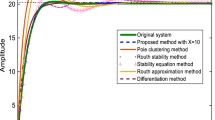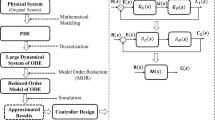Abstract
In this article, a new system diminution technique is proposed for the reduction in complexity and controller design of the higher-order models. This method is based on the Mihailov stability method which ensures the stability of the obtained simplified/micro-model if the higher-order plant is stable. In this technique, the reduced characteristic equation of the simplified plant is obtained by using the Mihailov stability technique and the reduced numerator equation is determined by using the improved Padé approximation technique. By using this reduced-order model, the PID controller is designed for the large-scale system. The accuracy and effectiveness of the proposed method are validated by comparing the step responses of the complete and lower-order models. The performance of the recommended technique is shown in terms of step responses and performance error indices. Three standard numerical systems are finally provided to validate the effectiveness and accuracy of the designed controller and the performance of the proposed model-order reduction technique.



Similar content being viewed by others
References
N. Ashoor, V. Singh, A note on low order modeling. IEEE Trans. Autom. Contr. 27(5), 1124–1126 (1982)
T.C. Chen, C.Y. Chang, Reduction of transfer functions by the stability-equation method. J. Franklin Inst. 308(4), 389–404 (1979)
T.C. Chen, C.Y. Chang, K.W. Han, Model reduction using the stability-equation method and the continued-fraction method. Int. J. Control 32(1), 81–94 (1980)
T.C. Chen, C.Y. Chang, K.W. Han, Model reduction using the stability-equation method and the Padé approximation method. J. Franklin Inst. 309(6), 473–490 (1980)
X. Cheng, J.M.A. Scherpen, Clustering approach to model order reduction of power networks with distributed controllers. Adv. Comput. Math. 44(6), 1917–1939 (2018)
B.N. Datta, Numerical Methods for Linear Control Systems (Elsevier Academic Press, USA, 2004)
Z. Duan, M.N.C. Bournazou, C. Kravaris, Dynamic model reduction for two-stage anaerobic digestion processes. Chem. Eng. J. 327, 1102–1116 (2017)
A. Fujimori, S. Ohara, Order reduction of plant and controller in closed loop identification based on joint input-output approach. Int. J. Control Autom. Syst. 15(3), 1217–1226 (2017)
A.K. Gaonkar, S.S. Kulkarni, Application of multilevel scheme and two level discretization for POD based model order reduction of nonlinear transient heat transfer problems. Comput. Mech. 55(1), 179–191 (2014)
G. Gu, All optimal Hankel-norm approximations and their error bounds in discrete-time. Int. J. Control 78(6), 408–423 (2005)
P. Gutman, C. Mannerfelt, P. Molander, Contributions to the model reduction problem. IEEE Trans. Autom. Control 27(2), 454–455 (1982)
W. Habchi, A Schur-complement model-order-reduction technique for the finite element solution of transient elastohydrodynamic lubrication problems. Adv. Eng. Softw. 127, 28–37 (2019)
M. Jamshidi, Large-Scale Systems: Modeling, Control and Fuzzy Logic (Prentice-Hall Inc, New York, 1983)
R. Komarasamy, N. Albhonso, G. Gurusamy, Order reduction of linear systems with an improved pole clustering. J. Vib. Control 18(12), 1876–1885 (2011)
E.D. Koronaki, P.A. Gkinis, L. Beex, S.P.A. Bordas, C. Theodoropoulos, A.G. Boudouvis, Classification of states and model order reduction of large scale chemical vapor deposition processes with solution multiplicity. Comput. Chem. Eng. 121, 148–157 (2019)
V. Krishnamurthy, V. Seshadri, Model reduction using the Routh stability criterion. IEEE Trans. Autom. Control 23(3), 729–731 (1978)
D.K. Kumar, S.K. Nagar, J.P. Tiwari, A new algorithm for model order reduction of interval systems. Bonfring Int. J. Data Min. 3(1), 6–11 (2013)
G. Langholz, D. Feinmesser, Model reduction by Routh approximations. Int. J. Syst. Sci. 9(5), 493–496 (1978)
W.Z. Lin, E.T. Ong, E.H. Ong, Efficient simulation of hard disk drive operational shock response using model order reduction. Microsyst. Technol. 15(10–11), 1521–1524 (2009)
Y. Liu, W. Yuan, H. Chang, B. Ma, Compact thermoelectric coupled models of micromachined thermal sensors using trajectory piecewise-linear model order reduction. Microsyst. Technol. 20(1), 73–82 (2014)
T.N. Lucas, Factor division: a useful algorithm in model reduction. IEEE Proc. D Control Theory Appl. 130(6), 362–364 (1983)
S.S. Mohseni, M.J. Yazdanpanah, A.R. Noei, Model order reduction of nonlinear models based on decoupled multimodel via trajectory piecewise linearization. Int. J. Control Autom. Syst. 15(5), 2088–2098 (2017)
B.C. Moore, Principal component analysis in control system: controllability, observability, and model reduction. IEEE Trans. Autom. Control 26(1), 17–36 (1981)
S.V. Ophem, A. van de Walle, E. Deckers, W. Desmet, Efficient vibro-acoustic identification of boundary conditions by low-rank parametric model order reduction. Mech. Syst. Signal Process. 111, 23–35 (2018)
D. Osipov, K. Sun, Adaptive nonlinear model reduction for fast power system simulation. IEEE Trans. Power Syst. 33(6), 6746–6754 (2018)
J. Pal, Stable reduced-order Padé approximants using the Routh-Hurwitz array. Electron. Lett. 15(8), 225–226 (1979)
S. Paul, J. Chang, Fast numerical analysis of electric motor using nonlinear model order reduction. IEEE Trans. Magn. 54(3), 1–4 (2018)
S. Paul, A. Rajan, J. Chang, Y.C. Kuang, M.P.L. Ooi, Parametric design analysis of magnetic sensor based on model order reduction and reliability-based design optimization. IEEE Trans. Magn. 54(3), 1–4 (2018)
W.C. Peterson, A.H. Nassar, On the synthesis of optimum linear feedback control systems. J. Franklin Inst. 306(3), 237–256 (1978)
A.K. Prajapati, R. Prasad, A new model order reduction method for the design of compensator by using moment matching algorithm. Trans. Inst. Meas. Control 42(3), 472–484 (2019)
A.K. Prajapati, R. Prasad, A new model reduction method for the linear dynamic systems and its application for the design of compensator. Circuits Syst. Signal Process. (2019). https://doi.org/10.1007/s00034-019-01264-1
A.K. Prajapati, R. Prasad, Failure of Padé approximation and time moment matching techniques in reduced order modelling, in 3rd IEEE International Conference for Convergence in Technology (I2CT), Pune, India, pp. 1–6 (2018)
A.K. Prajapati, R. Prasad, Model order reduction by using the balanced truncation method and the factor division algorithm. IETE J. Res. 65(6), 827–842 (2018)
A.K. Prajapati, R. Prasad, Order reduction of linear dynamical systems by using improved balanced realization technique. Circuits Syst. Signal Process. 38(11), 5298–5303 (2019)
A.K. Prajapati, R. Prasad, Order reduction of linear dynamic systems by improved Routh approximation method. IETE J. Res. 65(5), 827–842 (2018)
A.K. Prajapati, R. Prasad, Order reduction of linear dynamic systems with an improved Routh stability method, in IEEE International Conference on Control, Power Communication and Computing Technologies (ICCPCCT), Kerala, India, pp. 1–6 (2018)
A.K. Prajapati, R. Prasad, Padé approximation and its failure in reduced order modelling, in 1st International Conference on Recent Innovations in Electrical Electronics and Communication Systems (RIEECS), Dehradun, India, pp. 1–5 (2017)
A.K. Prajapati, R. Prasad, Reduced order modelling of LTI systems by using Routh approximation and factor division methods. Circuits Syst. Signal Process. 38(7), 3340–3355 (2019)
A.K. Prajapati, R. Prasad, Reduced order modelling of linear time invariant systems using factor division method to allow retention of dominant modes. IETE Tech. Rev. 36(5), 449–462 (2018)
A.K. Prajapati, R. Prasad, J. Pal, Contribution of time moments and Markov parameters in reduced order modeling, in 3rd IEEE International Conference for Convergence in Technology (I2CT), Pune, India, pp. 1–7 (2018)
R. Prasad, Padé type model order reduction for multivariable systems using Routh approximation. Comput. Electr. Eng. 26(6), 445–459 (2000)
M. Rasheduzzaman, J.A. Mueller, J.W. Kimball, Reduced-order small-signal model of microgrid systems. IEEE Trans. Sustain. Energy 6(4), 1292–1305 (2015)
P. Rosenzweig, A. Kater, T. Meurer, Model predictive control of piezo-actuated structures using reduced order models. Control Eng. Pract. 80, 83–93 (2018)
M.G. Safonov, R.Y. Chiang, A Schur method for balanced-truncation model reduction. IEEE Trans. Autom. Control 34(7), 729–733 (1989)
Y. Shamash, Linear system reduction using Padé approximation to allow retention of dominant modes. Int. J. Control 21(2), 257–272 (1975)
Y. Shamash, Stable reduced-order models using Padé-type approximations. IEEE Trans. Autom. Control 19, 615–616 (1974)
Y. Shamash, Truncation method of reduction: a viable alternative. Electron. Lett. 17(2), 97–98 (1981)
A. Sikander, R. Prasad, A new technique for reduced-order modelling of linear time-invariant system. IETE J. Res. 63(3), 316–324 (2017)
A. Sikander, R. Prasad, Linear time-invariant system reduction using a mixed methods approach. Appl. Math. Model. 39, 4848–4858 (2015)
A. Sikander, R. Prasad, Soft computing approach for model order reduction of linear time invariant systems. Circuits Syst. Signal Process. 34(11), 3471–3487 (2015)
V. Singh, Nonuniqueness of model reduction using the Routh approach. IEEE Trans. Autom. Control 24(4), 650–651 (1979)
N. Singh, R. Prasad, H.O. Gupta, Reduction of linear dynamic systems using Routh Hurwitz array and factor division method. IETE J. Edu. 47(1), 25–29 (2006)
J. Singh, C.B. Vishwakarma, K. Chattterjee, Biased reduction method by combining improved modified pole clustering and improved Padé approximations. Appl. Math. Modell. 40, 1418–1426 (2016)
A.K. Sinha, J. Pal, Simulation based reduced order modelling using a clustering technique. Comput. Electr. Eng. 16(3), 159–169 (1990)
T.J. Snowden, P.H.V.D. Graaf, M.J. Tindall, Methods of model reduction for large-scale biological systems: A survey of current methods and trends. Bull. Math. Biol. 79(7), 1449–1486 (2017)
A. Sootla, J. Anderson, On projection-based model reduction of biochemical networks part II: the stochastic case, in Proceedings of the 53rd IEEE Conference on Decision and Control, pp. 3621–3626 (2014)
S.K. Tiwari, G. Kaur, Improved reduced-order modeling using clustering method with dominant pole retention. IETE J. Res. 66(1), 42–52 (2018)
D. Tong, Q. Chen, Delay and its time-derivative-dependent model reduction for neutral-type control system. Circuits Syst. Signal Process. 36(6), 2542–2557 (2017)
D. Tong, P. Rao, Q. Chen, M.J. Ogorzalek, X. Li, Exponential synchronization and phase locking of a multilayer Kuramoto-oscillator system with a pacemaker. Neurocomputing 308, 129–137 (2018)
D. Tong, W. Zhou, X. Zhou, J. Yang, L. Zhang, Y. Xu, Exponential synchronization for stochastic neural networks with multi-delayed and Markovian switching via adaptive feedback control. Commun. Nonlinear Sci. Numer. Simul. 29(1), 359–371 (2015)
D.R. Towill, Transfer Function Techniques For Control Engineers (Illiffebooks ltd., London, 1970)
C.B. Vishwakarma, Order reduction using modified pole clustering and Padé approximations. Int. J. Electr. Comput. Energy Electron. Commun. Eng. 5(8), 998–1002 (2011)
C.B. Vishwakarma, R. Prasad, Clustering method for reducing order of linear system using Padé approximation. IETE J. Res. 54(5), 326–330 (2008)
P. Vorobev, P.H. Huang, M. Al Hosani, J.L. Kirtley, K. Turitsyn, High-fidelity model order reduction for microgrids stability assessment. IEEE Trans. Power Syst. 33(1), 874–886 (2018)
B.W. Wan, Linear model reduction using Mihailov criterion and Padé approximation technique. Int. J. Control 33(6), 1073–1089 (1981)
X. Wang, M. Yu, C. Wang, Structure-preserving-based model-order reduction of parameterized interconnect systems. Circuits Syst. Signal Process. 37(1), 19–48 (2018)
C. Xu, D. Tong, Q. Chen, W. Zhou, P. Shi, Exponential stability of Markovian jumping systems via adaptive sliding mode control. IEEE Trans. Syst. Man Cybernet. Syst. (2019). https://doi.org/10.1109/tsmc.2018.2884565
V. Zakian, Simplification of linear time invariant systems by moment approximations. Int. J. Control 18, 455–460 (1973)
Author information
Authors and Affiliations
Corresponding author
Additional information
Publisher's Note
Springer Nature remains neutral with regard to jurisdictional claims in published maps and institutional affiliations.
Rights and permissions
About this article
Cite this article
Prajapati, A.K., Rayudu, V.G.D., Sikander, A. et al. A New Technique for the Reduced-Order Modelling of Linear Dynamic Systems and Design of Controller. Circuits Syst Signal Process 39, 4849–4867 (2020). https://doi.org/10.1007/s00034-020-01412-y
Received:
Revised:
Accepted:
Published:
Issue Date:
DOI: https://doi.org/10.1007/s00034-020-01412-y




